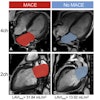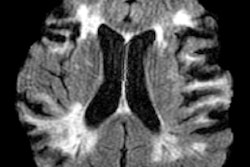
Researchers have developed an artificial intelligence (AI) algorithm that can be used with CT perfusion imaging to assess stroke patients' collateral flow, according to a study published September 8 in World Neurosurgery.
The findings could translate to improved workflow and care for patients with acute ischemic stroke, wrote a group led by Ryan Rava of the University at Buffalo in New York.
"This automated method for determining collateral filling could streamline clinical workflow, reduce bias, and aid in clinical decision-making for determining reperfusion [therapy]-eligible patients," Rava's team wrote.
Good collateral circulation is associated with better outcomes for stroke patients with large vessel occlusion who undergo reperfusion therapy -- that is, treatment with both thrombolytic drugs and surgery, according to the authors.
"Since collateral flow is inversely correlated to infarct size and slows the rate of infarct growth, determining patients with good collateral flow may allow clinicians to optimize patient selection and guide prognostic conversations," they noted.
Determining the state of a patient's collateral circulation can be time-consuming and complicated due to the vasculature of the brain. Clinicians tend to use CT angiography (CTA) to visualize collateral circulation; Rava's group sought to investigate whether AI could help doctors better categorize collateral flow on CT perfusion imaging using algorithms that could identify patients with good collateral filling (≥ 50%) and poor filling (< 50%).
The AI technology Rava and colleagues used included preprocessing software that extracted the skull region and gray and white brain matter, leaving a 3D image of contrast-enhanced blood vessels, as well as a convolutional neural network the team developed with Google's Keras machine-learning platform for the purpose of categorizing patients' collateral flow.
The study included 200 patients. Of these, 83% had collateral filling of less than 50% and 117 had filling of 50% or more. The algorithm showed high accuracy -- particularly with the combination of axial and anteroposterior views -- and specificity scores.
| Overall algorithm performance for categorizing collateral circulation in stroke patients | ||||
| Measure | Axial | Anteroposterior | 3D | Axial and anteroposterior |
| Accuracy | 79% | 76% | 76% | 80% |
| Sensitivity | 61% | 56% | 56% | 64% |
| Specificity | 86% | 85% | 83% | 85% |
| Positive predictive value | 64% | 62% | 59% | 65% |
| Negative predictive value | 84% | 82% | 82% | 85% |
| Area under the receiver operating curve (AUC) | 0.83 | 0.80 | 0.80 | 0.83 |
Time is of the essence for stroke patients and using AI with CT perfusion imaging could not only improve patient outcomes but also support less experienced clinicians, according to the authors.
"Since studies have shown reperfusion within the first 100 minutes following initial CT imaging leads to reduced mortality and improved functional outcome, an automated method for assessing collateral scoring is beneficial as it helps streamline the stroke protocol pipeline," they wrote. "This automated algorithm could be particularly beneficial for less experienced clinicians where assessing collateral flow may be challenging due to the miniscule size of the distal vessels [that indicate] the degree of collateral flow."




















